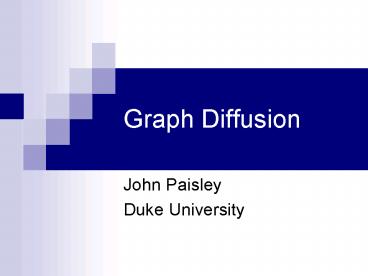Graph Diffusion - PowerPoint PPT Presentation
1 / 11
Title:
Graph Diffusion
Description:
Random Walk Graph. The first step for all applications is to define a ... A symmetric matrix that is adjoint to the original random walk matrix is also defined. ... – PowerPoint PPT presentation
Number of Views:63
Avg rating:3.0/5.0
Title: Graph Diffusion
1
Graph Diffusion
- John Paisley
- Duke University
2
Motivation
- Graph diffusion provides a new method for
answering old questions - What is the distance
- between 1,2,3?
- How would I cluster/label
- this dataset?
- What is an effective
- dimensionality reduction?
- Graph diffusion provides meaningful answers via
- Diffusion maps
- Diffusion distances
- Spectral clustering, etc.
3
Random Walk Graph
- The first step for all applications is to define
a kernel function, e.g. - With N data points, we obtain an N x N matrix
where closer points have a larger weight. The
kernel width, , controls the meaning of
closeness. - Using the total weight of a node (data point), we
normalize each row of the matrix, L, to obtain a
random walk matrix, M.
4
Symmetric Graph
- A symmetric matrix that is adjoint to the
original random walk matrix is also defined. - This means and share the same
eigenvalues, , and eigenvectors are related
as follows. - where is the jth eigenvector of and
and - are left and right eigenvectors of
5
Diffusion Mapping
- These right eigenvectors provide new coordinates
for the mapping with each dimension weighted by
its eigenvalue - For example, for the ith observation, the new
coordinates are - If d lt N, havent we increased the
dimensionality? - Answer Not necessarily. Since the eigenvalues
are decreasing - each dimension is weighted less. By looking at
the values of these eigenvalues, one can
threshold and select the top few dimensions,
discarding the rest.
6
Example 1 Spectral Clustering
- Spectral clustering is clustering in this
diffusion-mapped space. K-means or more
advanced clustering methods can be used.
- The mapping is shown in 2-D, though more
dimensions exist. Notice how diffusion mapping
has unwrapped the data manifold, making
clustering much easier. Now, Euclidean distance
is meaningful.
7
Example 2 Data Sorting
- Consider the task of sorting data by similarity.
Euclidean distance in the original space is not
always the best way to do this. - By diffusion mapping, we can sort along the
manifold. In a diffusion-mapped space, we simply
use the Euclidean distance.
8
Calculating Distances
- The diffusion distance is written below. In this
form, we can see that the eigenvalues effectively
weight the contribution of each dimension to the
final distance measure. - For a random walk of t steps, the matrix is
simply raised to that power and the
diffusion distance becomes - Only the eigenvalues change in how they weight
dimensions. Therefore, we can deduce that lower
eigenvectors contain coarser information and vice
versa. For this reason, diffusion maps can be
used for multi-scale problems.
9
Some Intuition Behind the Mapping
- Intuitively, the diffusion mapping can be
understood by writing the equations for one
eigenvector - The coordinate, xi, is proportional to a weighted
average of the coordinates of all other points.
10
Extension to New Data
- Considered this way, a simple extension can be
formulated for estimating the coordinates of the
(N1)st data point.
- We append a new row to consisting of the
normalized kernel values to all N existing
points. - If the first N data points adequately represent
all data that will come, we can easily and
quickly map new data without having to reconstruct
11
More Intuition A Direct Method
- The values of can be found from the
eigenfunctions - The Spectral Theorem
- Using the relation of the two matrices
eigenvectors - This leads to the following calculation of the
diffusion distance - The intuition is that the diffusion distance can
be (almost) viewed as the Euclidean distance
between rows of the random walk matrix. Instead
of measuring distance between a and b directly,
their distance is measured by their relative
distance to all other points in the dataset,
making this distance robust to noise.































